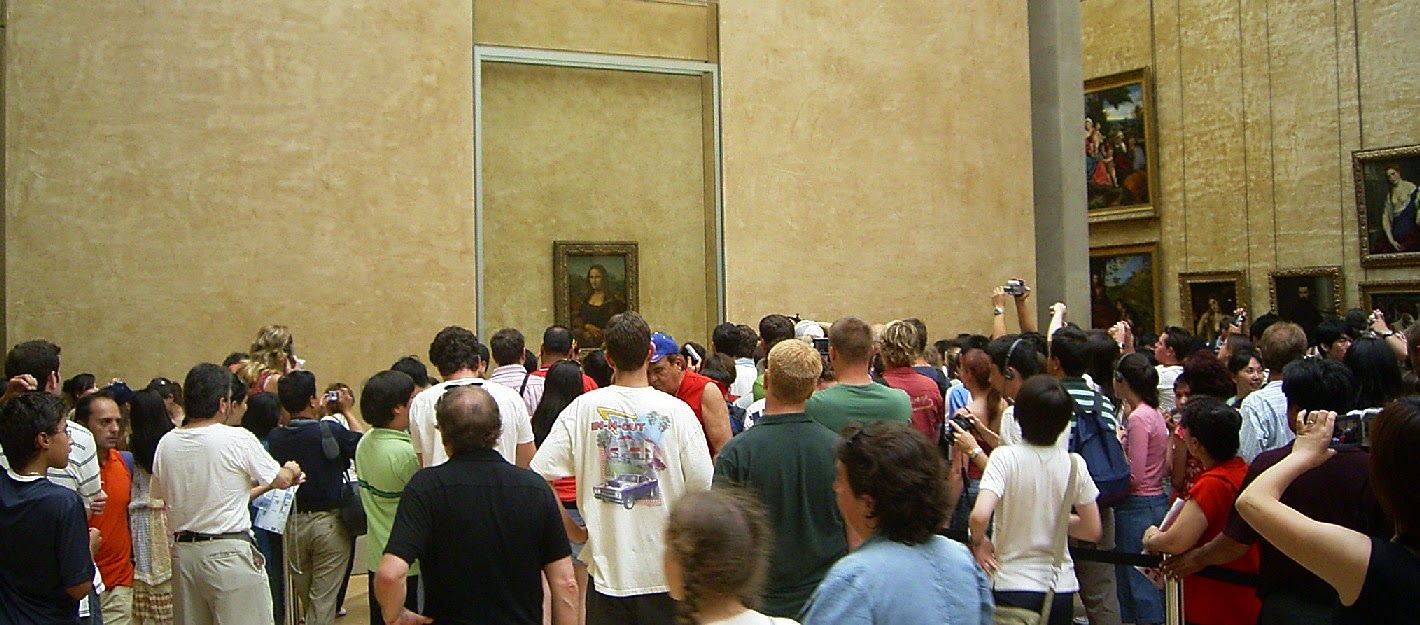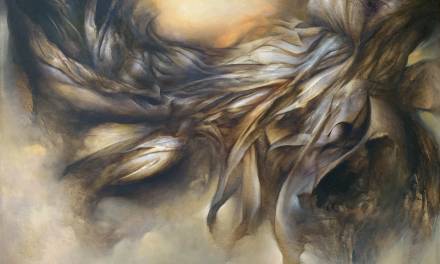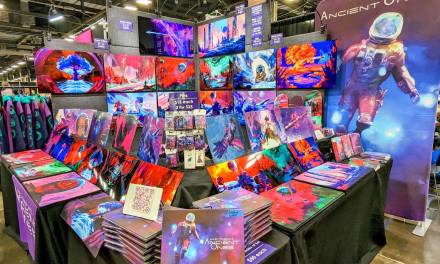by Arnie Fenner
Cathy and I had dinner with Irene Gallo and Greg Manchess just prior to Spectrum Fantastic Art Live in May. The food was good (at the Savoy, how could it not be?), the companionship superb, and the conversation lively. One topic was particularly intriguing and I thought it’d be interesting to share it with the Muddy Colors readers and see what you think.
How many significant—or “classic” or “major” or “masterful”—works does an artist have in them?
There are innumerable creators with solid bodies of work, who are respected and successful…you know, all-around good artists. But regardless of their success or the length of their careers, a “stand out” piece doesn’t immediately come to mind. There’s not one which, if mentioned, others around the table would nod with familiarity and admiration. Everything just blurs together as an overall impression.
No one can snap their fingers and magically decide to produce a masterpiece—and as I’ve said elsewhere, that term has been misused and misapplied in recent years—just as no one can sit down and intentionally create a classic novel, film, song, sculpture, or poem. The artist can do everything “right” but the response of the audience (or of peers, academics, or critics) is always unpredictable. What makes an image, story, or message resonate? What makes it stand out from the crowd? What makes it timeless?
And, of course, regardless of what any of us might think today (or want to happen in the future) we’ll never know who or what will be revered two hundred years from now, we’ll never know what will be ensconced in museums or analyzed in art history classes. We’ll never know what will be discarded and forgotten. Leonardo most certainly didn’t know when he painted the portrait of Lisa Gherardini that people would visit it, write songs about it, copy it, or parody it for 500+ years.
So…how does it happen? Is every artist, once they’ve reached a certain level of proficiency or skill, capable of creating a “significant” work that will withstand the test of time—and if they’re capable, will they? And if they don’t, why? What is it that takes an artist to the tipping point of greatness and gives them the last shove? What makes a masterful work seem almost inevitable for some and little more than an elusive wish for others? And…how deep is the well of creativity for an artist? How often can that well be drawn from before it starts to go dry—and once dry, can it be replenished?
Pour a glass of wine, sit back, and…discuss.








About ten years ago, Chicago economist David Galenson wrote a book called “Old Masters and Young Geniuses: The Two Life Cycles of Artistic Creativity” where he posed the question why some artists create their most beloved masterworks when they're young, while others are late bloomers. He comes up with interesting metrics (such as auction prices) for demonstrating which pieces are really the masterpieces.
Galenson distinguishes the two groups as “experimental innovators who work by trial and error, and arrive at their major contributions gradually, late in life. In contrast, conceptual innovators make sudden breakthroughs by formulating new ideas, usually at an early age.” More about Galenson here: http://chronicle.uchicago.edu/020124/quantifyingart.shtml
To answer your first question Arnie, I would suggest that the artists with the most masterpieces in them are probably the experimental innovators who are both productive and long-lived, such as Rockwell, Sargent, Lovell, Shishkin—and, to switch to music, Bach.
Thanks, Jim—and thanks for the link: an extremely interesting article. When it comes to abstract or Modern Art I can't even hazard a guess as to why this or that becomes “important.” But when it comes to illustration or figurative art, one of the points brought up during our dinner conversation was the significance of narrative in lasting works, which at least seems to suggest that the better the artist is at telling the story, the better the chance that they'll produce something that connects with viewers and lasts…
Masterpiece is a tricky word. Even pieces that stand the test of time are often, technically, no the artist's best. There has to be a luck and exposure element right? Show a piece enough and tell people, through books etc,. enough times that something is great and we accept it. But even with a list like Rockwell, Sargent et al there will still be enough “important” detractors to question the term masterpiece being attached. Maybe masterpiece is a media invention.
Detractors and fashions come and go, but masterworks rise and endure. Consider Bach's Mass in B minor, Mozart's Requiem, Verdi's Aida, Sargent's Lady Agnew, Rockwell's Breaking Home Ties, Wyeth's Christina's World, Pyle's Marooned, Wells' Citizen Kane, Beatles' Sargent Pepper's. The consensus can be tested in many ways: how many times the piece is reproduced or recorded, or which get the most searches online.
Yes, popular tastes can drift somewhat over time, and marketing can temporarily push a mediocre work ahead of a hidden gem. Were it not for Mendelssohn, Bach might have been lost in obscurity.
But given a reasonable chance to prove their worth, certain works do rise above the rest, and every artist, even in their own lifetimes, know which pieces those are.
I'm with Bill on this one, there even has been research on the subject: http://www.npr.org/2014/02/27/282939233/good-art-is-popular-because-its-good-right
I, for one, think the Mona Lisa kinda sucks…
Agreed. Though “masterpiece” dates back to the 1600s, it is often woefully misapplied today. But as Jim mentions, there are obviously works that have some sort of broad consensus of importance, that do so regardless of critics telling us they're significant. Perhaps “magnum opus” would be a better term. 🙂
There is no masterpiece that is undisputed. Mainly because there will always be somebody (or, sadly, many) who, for reasons better left unexamined, must be contrary, or petulant, or anti-art, etc. The rationales for such contrarity, petulance, or anti-art rarely have anything to do with art. And such views, passionate or petulant, shouldn't automatically send us reeling into the swirling pit of relativism just to be accomodating.
Which is to say, dissenters from serious cultural discussion shouldn't be allowed to govern the conversations that cultured people may have about intrinsic aesthetic value.
Masterpiece, it seems to me, just means a work of art with tremendous intrinsic aesthetic value, wherein every controllable aspect of it has been orchestrated to achieve its singular unity of effect.
Just rambling here: In the abstract, I believe the determining fundamentals of a masterpiece (magnum opus) are the same three aspects prosecutors would seek to establish in a criminal investigation: means, motive, and opportunity.
Means is likely self-evident. Does the artistic creative possess the requisite tools, technique, and talent to craft the work? “Talent” meaning practiced skill and execution of vision; not “talent as a special quasi-mystical ability divorced from effort”. Technique could be distilled into two separate approaches: execution that is already popularly accepted or one that is new and breaks from established patterns. If the former, it likely must represent the pinnacle of technical handling. The latter is often considered groundbreaking and sets a new standard or inspires one.
Motive is inspiration toward an artistic vision. The creative must be vested in pursuit of the craft. Even if the work is only meaningful to them as an individual, the creative is drawn into the work and absorbed by the execution. I imagine the specific piece must be more than a “by the numbers” project for the artist. It must become more than just a piece for a paycheck while they are working at it. Even a project that is going awry may be salvaged by an inspired response to frustration or a happy accident. Whatever motivates the individual artist, I doubt that a work they consider rote and mundane will serve as their magnum opus.
Opportunity is more than the time and space in which to create. It is also the time and place to be exposed AND the proper audience to receive the work. This is where the work escapes the studio and finds life in the world at large. If a tree falls in the forest and no one is there to hear it, it does not matter if it makes a noise, is silent, shrieks, or sings. No one is there to hear it. So, the masterwork of a creative needs an audience to esteem and value it to achieve enduring cultural status. Zeitgeist matters here. If the work confirms and exemplifies the time and place, it is lauded. If it challenges and invigorates, it will be lauded. If it is of no import to the audience, it will be met with indifference and very likely will not achieve recognition at all, or not until a new audience receptive to the work finds it.
I have a bunch of tangental thoughts, but (Jack Bauer voice…) “There’s no time!”
I've been writing several posts on my Art Contrarian blog dealing with fine arts painters and illustrators who were technically good, yet haven't attained anything like lasting fame (so far). In those posts (some of which are still in the publication queue), I contend that those artists never attained a distinctive personal style during their careers, which is why they are semi-forgotten — they often went from style to style and never settled down.
For the sake of argument, let's say my conjecture is valid. Then it would follow that technically skilled artists who have developed a strong personal style and (with some help from chance, in some cases) attained strong recognition are likely to have made some works that are memorable to the public for the various reasons citied in other comments. One might call it a matter of statistics, once the conditions are in place.
This is not to say that an artist can't come up with one “masterpiece” over a career with the rest of his work out there in oblivion. All I'm suggesting is that personal style is perhaps the most helpful ingredient once skill is present.
These are all thoughtful posts: much thanks to all!
A friend of my, Aaron Albrecht, sent me an email about this post and I thought I'd share part of it:
“I noticed your recent topic on Muddy Colors on artist's creating masterpieces at different stages of life. One word that didn't come up was inspiration. To my way of thinking illustrators have an advantage in that regard because at any time of life they can read words that (even come to a classic late in life) they must bring to visual life. Of course it also depends on the skill melding with the the spark. Bernie Wrightson forged page after page of Frankenstein at the peak of his career. And honestly it doesn't have to be the written word: William Stout's various travels have
inspired him. I don't think the inspiration well runs dry, as long as the artist has eyes to see or ears to hear.”
Agreed, in publishing especially it's easy to confuse the most well-known works (which often has a lot to do with the material it's attached to) vs judging a masterpiece purely by the skill of the artist. It's rare that my favorite piece by an illustrator is their most-recognized piece, which often happens bc it's the “important” projects that have so many approvers/cooks in the kitchen mucking it up…but that's a whole OTHER article.
Count on James Gurney to have researched, thought about, remembered, and have something useful to add on this subject! 🙂